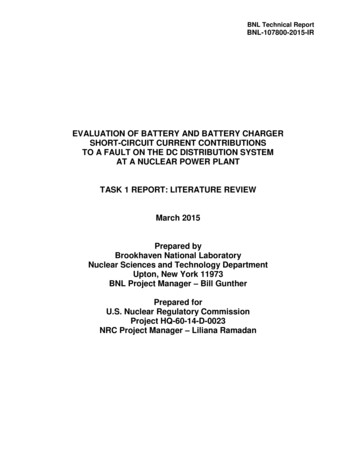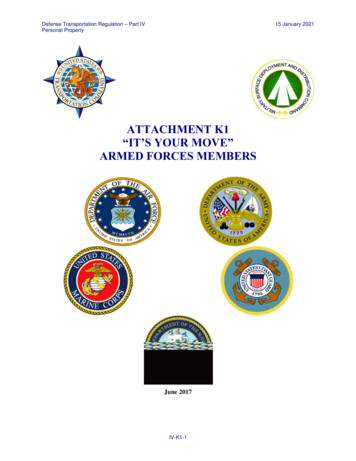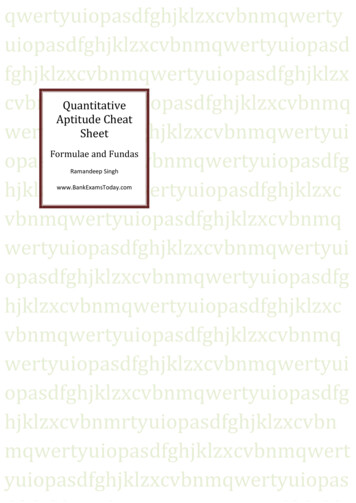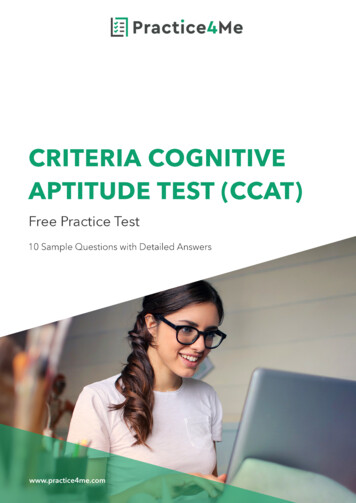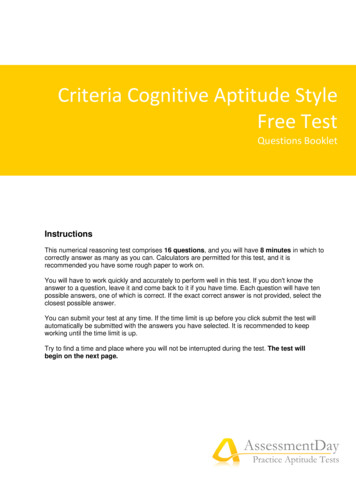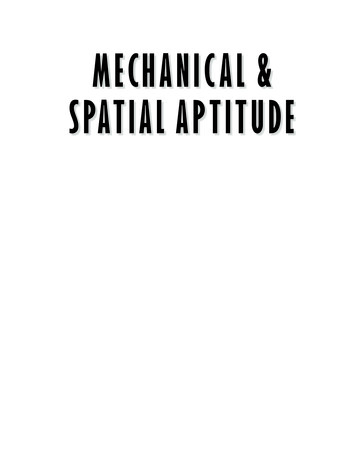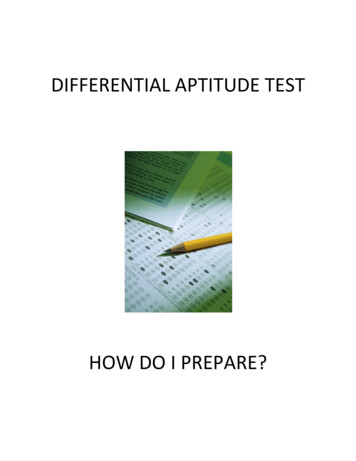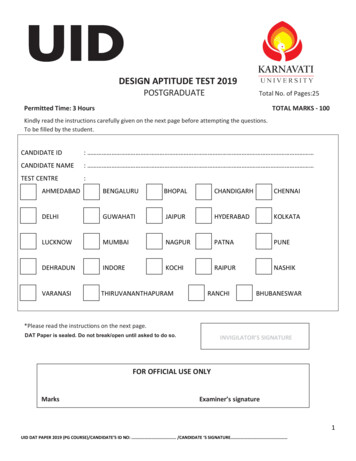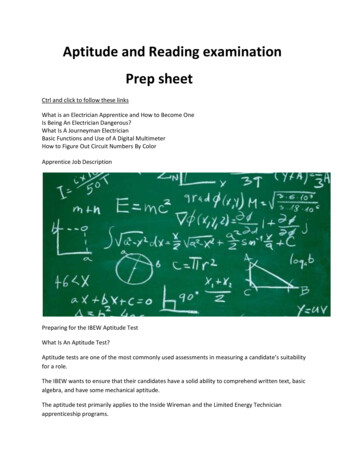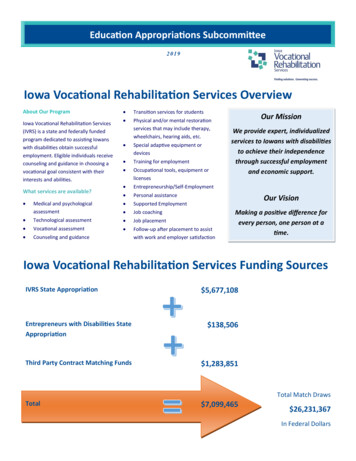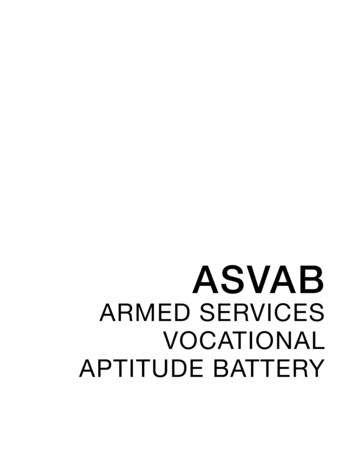
Transcription
ASVABARMED SERVICESVOCATIONALAPTITUDE BATTERY
ASVABARMEDSERVICESVOCATIONALAPTITUDEBATTERYThird Edition NEWYORK
Copyright 2005 LearningExpressAll rights reserved under International and Pan-American Copyright Conventions.Published in the United States by LearningExpress, LLC, New York.Library of Congress Cataloging-in-Publication Data:ASVAB.—3rd ed.p. cm.ISBN 1-57685-482-51. Armed Services Vocational Aptitude Battery—Study guides. I. LearningExpress(Organization)U408.5.A83 2005355'.00973—dc222004027515Printed in the United States of America9 8 7 6 5 4 3 2 1Third EditionRegarding the Information in This BookWe attempt to verify the information presented in our books prior to publication. It is always agood idea. however, to double-check such important information as minimum requirements,application and testing procedures, and deadlines with your local recruitment agncy, as suchinformation can change from time to time.For more information or to place an order, contact LearningExpress at:55 Broadway8th FloorNew York, NY 10006Or visit us at:www.learnatest.com
ContentsCHAPTER 1About the ASVAB1CHAPTER 2Getting Into the Military7CHAPTER 3The Score You Need for the Job You Want15CHAPTER 4The LearningExpress Test Preparation System29CHAPTER 5ASVAB Practice Test 145CHAPTER 6General Science Review83CHAPTER 7Math Review99CHAPTER 8Word Knowledge Review137CHAPTER 9Paragraph Comprehension Review147CHAPTER 10Auto and Shop Information Review159CHAPTER 11Mechanical Comprehension Review173CHAPTER 12Electronics Information Review185CHAPTER 13ASVAB Practice Test 2199CHAPTER 14ASVAB Practice Test 3235HOW TO USE THE CD-ROM271v
ContributorsThe following individuals contributed to the content of this book.Elizabeth Chesla is the author of 501 Vocabulary Questions, TOEFL Exam Success, Reading Comprehension Success, Write Better Essays, and contributing author of GMAT Exam Success, ACT Exam Success, GED Exam Success,and many other writing and reading guides and test-preparation books. She lives in Harleysville, Pennsylvania.Pamela Harrell is an editor and writer living in New York City; she has a master of science degree in entomology.Mary Hesalroad, a police officer for the Austin, Texas, Police Department, consults with police departments onrecruiting efforts and is a freelance writer.Clay McGann is an electrical engineer who designs electrical systems for space launch vehicles.Judith N. Meyers is director of the Two Together Tutorial Program of the Jewish Child Care Association in NewYork City and formerly an Adult Basic Education Practitioner at City University of New York.Judith Robinovitz is an independent educational consultant and director of Score at the Top, a comprehensivetest preparation program in Vero Beach, Florida.Jo Lynn Southard is a freelance writer and editor living in Portland, Maine.Shirley Tarbell is a test development specialist and writer living in Portland, Maine.Steven Truitt, P.E., is a civil engineer and technical writer specializing in environmental engineering and pollution control in Golden, Colorado.vii
ASVABARMED SERVICESVOCATIONALAPTITUDE BATTERY
C H A P T E R1Aboutthe ASVABCHAPTER SUMMARYThis chapter will introduce the Armed Services Vocational AptitudeBattery, or ASVAB, describe what is contained in it, and explain how thisbook can help you prepare to achieve maximum success when youtake it.The ASVAB is a multiple-aptitude test battery consisting of eight subtests on various subjects. The eightsubtests that make up the ASVAB, each covering a different subject area and each carefully timed, areshown on the table on the next page. (A more complete description of each test will follow later inthis chapter.) The ASVAB is used for two main purposes: As a military recruiting tool of the U.S. Department of Defense to test potential recruits to determine theirdeveloped abilities (that is, to gauge what they already know about certain subjects); to measure their general learning ability and vocational aptitude; and to predict performance in certain academic areasAs a guide for high school and post-secondary school students, to help them decide on the career paths forwhich they might best be suited, whether in the military or in some other fieldDepending on where you take the ASVAB, you will take either the computer version or the paper-and-pencil version. Candidates for enlistment taking the ASVAB at a Military Entrance Processing Station (MEPS) willtake the computer version, while candidates for enlistment taking the ASVAB at a reserve center or MobileExamination Team (MET) site will take the paper-and-pencil version. The content of the test is the same on bothversions; only the format, the mechanics of scoring, and the numbers of questions asked are different. TheLearningExpress CD-ROM for the ASVAB, included with this book, provides plenty of review material (which1
– ABOUT THE ASVAB –NUMBER OF ITEMS AND TESTING TIME FOR THE ASVABSubtestNumber of QuestionsTime (Minutes)General Science (GS)2511Arithmetic Reasoning (AR)3036Word Knowledge (WK)2511Paragraph Comprehension (PC)1513Auto and Shop Information (AS)2511Mathematics Knowledge (MK)3524Mechanical Comprehension (MC)2519Electronics Information (EI)209200 Items134 MinutesTotal will be useful no matter which version of the ASVAByou take) and also prepares you to take the computerbased test.Most sections of the ASVAB—General Science,Arithmetic Reasoning, Word Knowledge, Auto andShop Information, Mathematics Knowledge, Mechanical Comprehension, and Electronics Information—depend on your knowing about the subject from yourhigh school courses or other reading.The one section that does not depend on yourknowing the subject in advance is the Paragraph Comprehension section. For the Paragraph Comprehension questions, you will be able to find the answersusing only the information given in the paragraph andquestions that accompany it.The Eight ASVAB SubtestsFollowing is a more detailed description of each of theeight subtests in the ASVAB. There’s a chapter in thisbook on each of the subtests.Part 1: General ScienceThe General Science subtest of the ASVAB consists of25 questions that are designed to measure your abilityto recognize, apply, and analyze basic scientific principles in the areas of: Life science: botany, zoology, anatomy and physiology, ecologyPhysical science: force and motion, energy, fluidsand gases, atomic structure, chemistryEarth and space science: astronomy, geology,meteorology, oceanographyGeneral Science questions are covered in Chapter6 of this book.2
– ABOUT THE ASVAB –answer the questions will be found in the passage. Thequestions are designed to test your ability to obtainthe following kinds of information from writtenmaterial:Part 2: Arithmetic ReasoningThe Arithmetic Reasoning subtest consists of 30 wordproblems describing everyday life situations, which aredesigned to measure your reasoning skills and understanding of: Operations with whole numbersOperations with fractions and decimals or moneyRatio and proportionInterest and percentageMeasurement of perimeters, areas, volumes, andtime and temperature Chapter 7 will show you how to deal with theword problems on this subtest.Chapter 9 gives you the skills you need to do well in thissubtest.Part 3: Word KnowledgePart 5: Auto and ShopInformationThe Word Knowledge subtest consists of 25 questionsthat ask you to choose the correct definitions of verbs,nouns, adjectives, and adverbs. These questions comein two forms: Literal comprehension: your ability to identifystated facts, identify reworded facts, and determine sequence of eventsImplicit, inferential, or critical comprehension:your ability to draw conclusions; identify themain idea of a paragraph; determine the author’spurpose, mood, or tone; and identify style andtechniqueThe Auto and Shop Information subtest includes 25questions on automotive repair and building construction. General shop practices are also included.The questions are on the following topics:Definitions presented alone, with no contextWords in the context of a short sentence The vocabulary skills you need for the Word Knowledgesubtest are presented in Chapter 8. Part 4:Paragraph Comprehension The Paragraph Comprehension subtest is 15 questions based on several short passages written on avariety of topics. No prior knowledge of the subjectwill be required—all the information you will need to Automotive componentsAutomotive systemsAutomotive toolsAutomotive troubleshooting and repairShop toolsBuilding materialsBuilding and construction proceduresAuto and Shop Information is covered in Chapter 10 of this book.3
– ABOUT THE ASVAB –Part 6: Mathematics Knowledge The Mathematics Knowledge subtest consists of 35questions designed to measure your understanding ofmathematical concepts, principles, and procedures.The emphasis is on your ability to recognize and applybasic mathematical principles. The questions cover: Number theory: factors, multiples, reciprocals,number properties, primes, integersNumeration: fractional parts, decimals, percentages, and conversions; order of operations; exponents; rounding; reducing fractions; roots andradicals; signed numbersAlgebraic operations and equations: solving ordetermining equations, factoring, simplifyingalgebraic expressions, converting a sentence to anequationGeometry and measurement: coordinates andslope, Pythagorean theorem, angle measurement,properties of polygons and circles, perimeter,area, volume, unit conversionProbabilityMechanical motion: friction, velocity, direction,acceleration, centrifugal forceFluid dynamics: hydraulic forces, compressionProperties of materials: weight, strength, expansion/contraction, absorption, center of gravityStructural supportSee Chapter 11 for everything you need to knowabout Mechanical Comprehension.Part 8: Electronics InformationThe Electronics Information subtest consists of 20questions on electrical and electronics systems. Thesequestions are designed to measure basic knowledgeand principles of electrical and electronics systems: Electrical tools, symbols, devices, and materialsElectrical circuitsElectricity and electronic systemsElectrical current: voltage, conductivity, resistance, groundingChapter 12 covers Electronics Information.These mathematical concepts are covered inChapter 7 of this book. Part 7:Mechanical ComprehensionIf you are in high school, ask your guidance counselorabout taking the ASVAB. Many high schools offer theASVAB at a specific time during the school year.If you’re on your own, go to the nearest recruiterof the branch of the armed services you’re interested in.There is no charge to take the ASVAB. Taking the examdoesn’t obligate you to join the military, although youcan probably expect a persuasive sales pitch for themany job opportunities available through the Army, AirForce, Navy, Marine Corps, and U.S. Coast Guard. Formore details about the ASVAB, see the Army’s ASVABwebsite at www.goarmy.com.The Mechanical Comprehension subtest consists of 25problems, many of them illustrated, on generalmechanics and physical principles. The questions willcover the principles of simple machines such as gears,pulleys, and levers, as well as force and fluid dynamics.Problems involving basic properties of materials arealso included. The questions may consist of knowledge, application, and analysis questions on: Arranging to Take the ASVABBasic compound machines: gears, cams, pistons,cranks, linkages, belts, chainsSimple machines: levers, planes, pulleys, screws,wedges, wheels, axles4
– ABOUT THE ASVAB – What the ASVAB Means for YouIf you’re taking the ASVAB as a high school studentwith no intention of entering the military, the test is,for you, simply an aptitude test that will help you findout what kinds of things you’re good at and whatthings might not make such good career paths. YourASVAB results can help you decide whether or not togo to college or whether to get training for a specializedcareer in an area such as electronics. Your scores mayalso show you areas that you should probably avoid—things you have less aptitude or training for thanwould be required by many jobs in that area. Yourguidance counselor will explain your score report andhow to use it.If you want to enter the military, more is riding onyour ASVAB score. Approximately 500,000 people eachyear take the ASVAB in order to enlist in the military.Your scores on certain subtests of the ASVAB determinewhether you can get in at all. Once you’re in, scores onthe various subtests determine which jobs, or MilitaryOccupational Specialities, you’ll be allowed to trainfor. For instance, if you want to learn to be a computeroperator, you need good scores in Paragraph Comprehension, Word Knowledge, Mathematics Knowledge,General Science, and Mechanical Comprehension. SeeChapter 3 for more details on what your score meansto your choice of military careers.The bottom line is that you want to score well onthe ASVAB if you’re looking toward a career with thearmed forces. And this book is here to help.How to Use This Bookto Increase Your ScoreThe key to success in almost any field is, of course, toprepare for all you’re worth. And one of the very bestways to prepare for the ASVAB is to read and study thisbook, take the practice tests, and measure how you’redoing as you pass each milestone.To ensure you are clear on the basic information,start by reading Chapter 2, which explains the recruitment and enlistment process, and how the ASVAB fitsinto that process. To learn more about the score youneed for the job you want, read Chapter 3 next.Next, Chapter 4 takes you through the LearningExpress Test Preparation System. The 9 steps in thischapter will ensure you are in top physical and mentalshape to do your best on test day.Armed with the knowledge you have gained in thefirst four chapters, take the first of three practice testsin Chapter 5. By taking this test, you will be able to seehow
CHAPTER 11 Mechanical Comprehension Review 173 CHAPTER 12 Electronics Information Review 185 CHAPTER 13 ASVAB Practice Test 2 199 CHAPTER 14 ASVAB Practice Test 3 235 HOW TO USE THE CD-ROM 271 Contents v. The following individuals contributed to the content of this book. Elizabeth Cheslais the author of501 Vocabulary Questions, TOEFL Exam Success, Reading Comprehension

